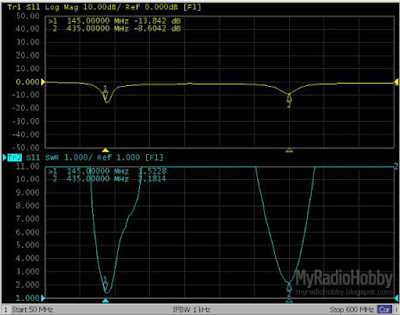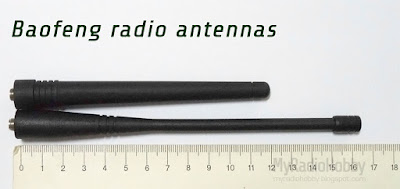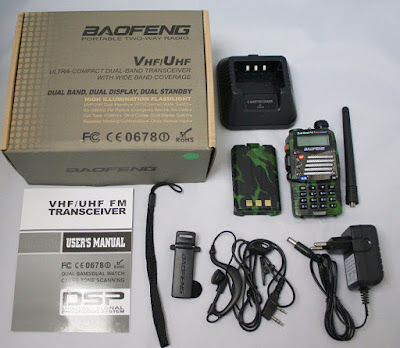The Baofeng UV-5R is one of the most popular portable dual-band VHF-UHF two-way FM radios available. They are well suitable for use on the 2m and 70cm amateur radio bands. A decent set of features and specs and a very low price tag are the recipe for success. You can
buy a Baofeng UV-5R for less than 30 USD delivered. Now that's value for money!
This is a quick review of the Baofeng UV-5R, based on my experience with a UV-5RA radio.
At the heart of the UV-5R is the RDA1846, a highly integrated single-chip transceiver for Walkie Talkie applications. The chip integrates nearly all the functional blocks needed to build a Walkie Talkie. A powerful integrated DSP (digital signal processor) accomplishes both the demodulation and modulation of the FM signal. The RDA1846 specs guaranty operation from 400MHz to 500MHz and from 134MHz to 174MHz. The radio has excellent sensitivity and wide/narrow bandwidth selection, which is great for receiving weak signals. It's possible to receive several popular amateur radio satellites and the ISS with just the provided whip antenna. With a software hack it is even possible to receive part of the Air band.
Programming
The UV-5R can be programmed using the supplied Baofeng software or using the more advanced CHIRP program. A special USB to serial programming cable is needed. Fortunately these cables are very cheap. If you just want to program your frequencies or menu settings you can do so using the radio's keypad. But you can only program channel names via software. I strongly recommend using a Baofeng radio programming cable.
One of the most interesting things about the UV-5R is that its
frequency range (VHF and UHF) can be expanded via a software hack. For example, you could modify the
VHF band limits to go as low as 127Mhz (receive only!), well into the Air band and well below the factory default 136Mhz VHF limit.
Display
One of the UV-5R high points is its LCD display. It uses a backlit matrix LCD which has excellent visibility and readability even at extreme angles.
Signal meter
Unfortunately the Baofeng UV-5R doesn't have a signal strength meter. The LCD indicator just shows a signal icon when the radio receives a signal at a level above the squelch level, but it does not show signal strength variation. This is a shame since the lower priced UV-3R has a signal strength indicator.
Squelch
Another complaint regarding the UV-5R is the squelch function. Despite having 10 squelch levels (0 - 9), the levels are not correctly defined and, as a result of this, squelch does not work well. For example, there is little (if any) difference in setting the squelch level at 1 or 3. However the squelch levels can be altered via a software hack.
Antenna
The UV-5R is sold with a small "rubber duck" or whip type antenna.
Depending on the exact UV-5R model, the antenna is either 12cm or a slightly longer (and better) 16cm. The radio uses a reverse SMA connection, so an adaptor will be needed to use regular SMA or BNC antennas. I prefer BNC connectors since they faster to use than SMA. This way I can quickly switch from a small whip antenna to my Yagi antennas which use BNC connectors.
FM radio
The Baofeng UV-5R is capable of broadcast FM radio reception (65-108MHz) with station scan functionality. Unfortunately stations can't be stored on the UV-5R, but the radio is very sensitive.
Models and accessories
The Baofeng UV-5R is available in several "variation" models. There is the UV-5R, UV-5RA, UV-5RE, UV-5R+ and other less popular variations. I bought the UV-5RA, but all models are functionally the same. Most differences are cosmetic variations of case and colours. Regarding the case, it's quite robust, easily resisting small drops without major damage. However, some models like the Baofeng UV-5R+ are sold with a slightly bigger (16cm vs. 12cm) and better antenna. The radio is sold with a rechargeable battery, battery charger, earphone/mic, belt clip, wrist strap and whip antenna. Before buying one I recommend checking with the seller the exact model and accessories that come with it. I also recommend getting a Baofeng UV-5R programming cable.
Firmware upgrades
Unfortunately the Baofeng UV-5R is NOT firmware upgradable. This is because the firmware chip is a write once-device, it can't be re-flashed. The only reliable way to know what firmware your UV-5R has is to use the CHIRP program.
Main specs:
Frequency range: 136-174MHz (VHF), 400-520MHz (UHF).
5 watt maximum output power.
Wideband (25kHz) and Narrowband (12.5kHz).
Dual Band, Dual Display and Dual Standby.
Dual watch on same or different band.
CTCSS/DCS/DTMF tone options.
128 programmable memory channels.
Customizable channel names.
Note: older versions of the Baofeng UV-5R may have different specs.
Download the
Baofeng UV-5R user manual from Baofeng.
Strengths
Very low price.
Good feature set.
Excellent sensitivity.
Display with excellent visibility and readability.
Programmable via software.
Programmable via keypad.
Direct frequency entry.
2.5Khz frequency step.
FM radio.
Flashlight.
Many accessories available.
Weaknesses
No signal strength indicator.
Badly implemented squelch (but can be fixed with software hack).
Somewhat noisy earphone audio.
VERDICT
The Baofeng UV-5R is probably the best "bang for the buck" two-way radio on sale. It is not perfect, but considering the features and specs and the fact that "big brand" radios of similar specs cost much, much more, it's a bargain.
Buy the Baofeng UV-5R
Buy the Baofeng UV-5R from Banggood
Buy the Baofeng UV-5R from Dealextreme
WARNING:
If you are new to amateur radio, please be aware that to transmit in the amateur radio bands you must be a licensed amateur radio operator. To operate a radio on receive (listening) mode you do not need a license.















